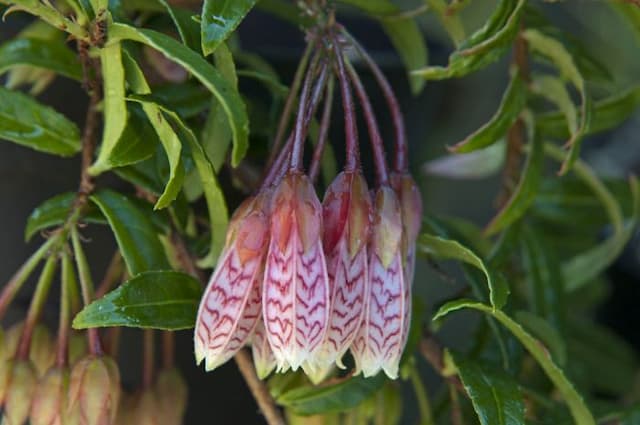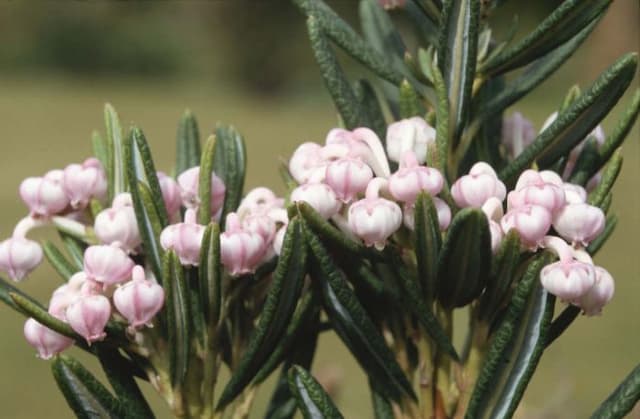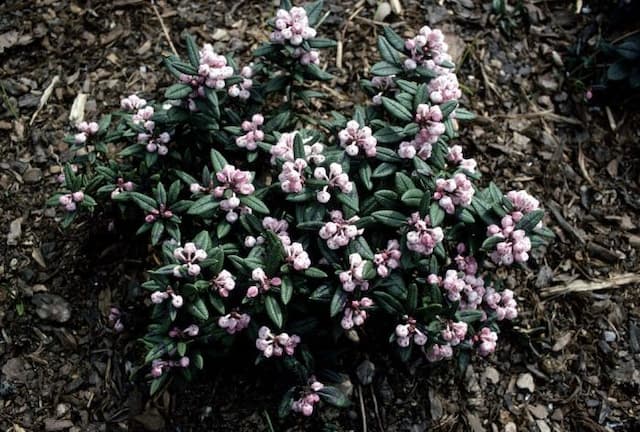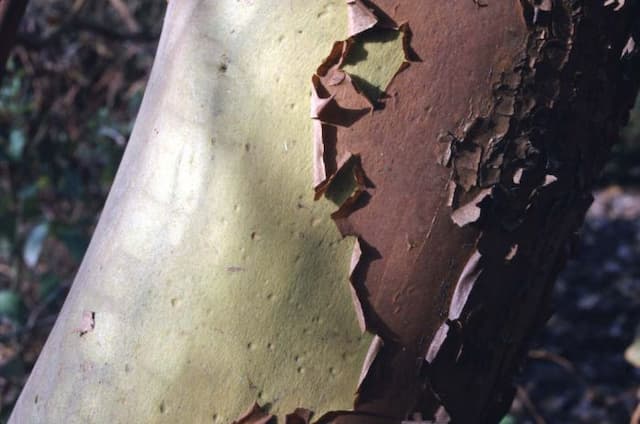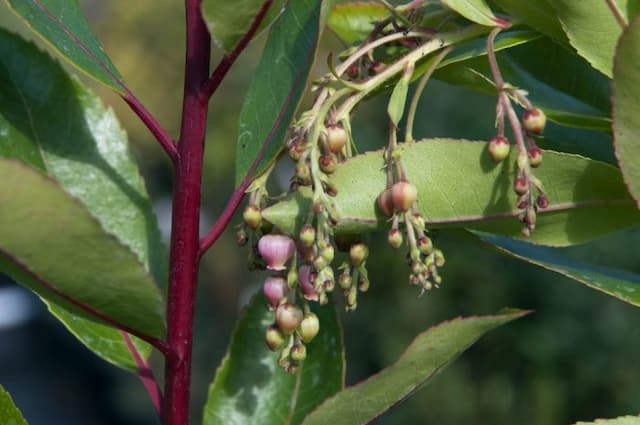Rhododendron Rhododendron (Solent Group) 'Drury Lane' (K)
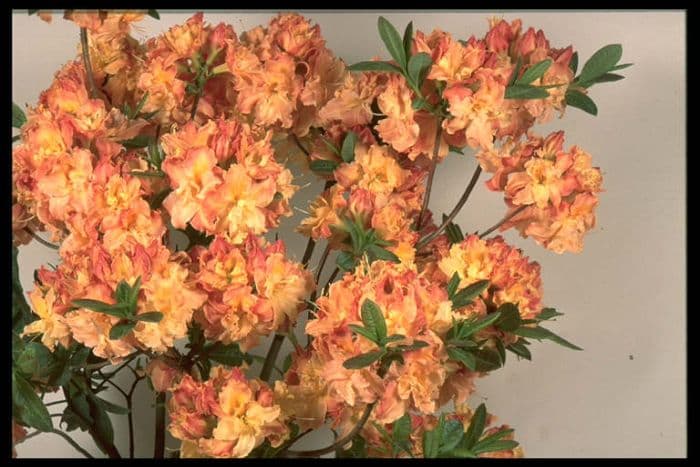
ABOUT
The Rhododendron 'Drury Lane' is notable for its visually striking features that exude both lushness and vibrancy. Its foliage is a glossy, deep green, which sets the stage for its spectacular blooms. The flowers emerge with an enthralling display of color, typically showcasing rich shades that can range from a deep pink to a bold red hue. Each blossom is composed of large, trumpet-shaped flowers, boasting a pleasing symmetry with a prominent lobe structure that amplifies their ornate look. These blooms cluster together to form a rounded truss, creating a dramatic effect against the backdrop of the evergreen leaves. The plant carries a dense, bushy appearance with a well-branched structure that lends to its overall fullness and presence in the garden. The Rhododendron 'Drury Lane' thus presents a regal and colorful aspect that captures attention and contributes to the aesthetic appeal of any landscape in which it is situated.
About this plant
 Names
NamesFamily
Ericaceae
Synonyms
Drury Lane Rhododendron
Common names
Rhododendron 'Drury Lane'
 Toxicity
ToxicityTo humans
Rhododendron, including the variety 'Drury Lane', contains toxins known as grayanotoxins. If any part of the plant is ingested by humans, it can cause symptoms such as vomiting, diarrhea, hypersalivation, weakness, and potentially cardiac failure. In severe cases, consuming rhododendron may lead to coma or even death.
To pets
Rhododendron is also poisonous to pets, and like in humans, all parts of the plant contain grayanotoxins. If pets ingest rhododendron, they may experience vomiting, diarrhea, drooling, weakness, and can suffer from heart arrhythmias and low blood pressure. Severe poisoning can lead to coma or death, particularly in smaller pets.
 Characteristics
CharacteristicsLife cycle
Perennials
Foliage type
Evergreen
Color of leaves
Green
Flower color
Mixed
Height
6 feet (1.8 meters)
Spread
6 feet (1.8 meters)
Plant type
Shrub
Hardiness zones
5
Native area
Asia
Benefits
 General Benefits
General Benefits- Attractive Blooms - Rhododendron 'Drury Lane' is known for its stunning flowers that add visual appeal to any garden or landscape.
- Diverse Landscaping Use - This variety is suitable for use in mixed borders, as a specimen plant, or in woodland garden settings.
- Pollinator Friendly - The blooms attract various pollinators, supporting local ecosystems and beneficial insect populations.
- Seasonal Interest - With its flowering time in spring, this rhododendron adds seasonal interest to gardens when many other plants are not yet in bloom.
- Shade Tolerance - Rhododendrons can tolerate partial shade, making them versatile for different garden locations.
- Evergreen Foliage - As an evergreen, it provides color and structure to the garden year-round, even in the winter months.
- Low Maintenance - Once established, Rhododendrons generally require minimal care beyond occasional pruning and watering.
 Medical Properties
Medical PropertiesThis plant is not used for medical purposes.
 Air-purifying Qualities
Air-purifying QualitiesThis plant is not specifically known for air purifying qualities.
 Other Uses
Other Uses- Rhododendrons can be used to create a natural dye for fabrics. The flowers, when boiled, can yield a range of colors from pale yellows to vibrant pinks, depending on the cultivar and mordant used.
- The large, evergreen leaves of rhododendrons can be used as natural platters or wraps for food, adding a unique presentation for outdoor dining experiences.
- Certain rhododendron species’ wood is hard and dense, making it suitable for the creation of small wood-crafted items such as handles, buttons, or even chess pieces.
- Leaves from the rhododendron can serve as a natural insect repellent. Crushed leaves can be rubbed onto skin to release essential oils that some insects may find unappealing.
- Rhododendron blossoms are sometimes used in flower arranging and ikebana, the Japanese art of flower arrangement, due to their vibrant colors and large, showy clusters.
- The thick foliage of rhododendrons can provide natural shelter for small wildlife, such as birds and beneficial insects, within a garden ecosystem.
- Rhododendron leaves have been traditionally used to polish wood when dried and crushed into a fine powder, which can then be applied with a soft cloth.
- Used in landscape photography, rhododendrons with their vibrant blooms can serve as an excellent foreground subject to add depth and interest to scenic photos.
- The acidic nature of the soil preferred by rhododendrons can be utilized to acidify soil in other parts of the garden, supporting plants with similar soil pH requirements.
- Dried rhododendron petals can be mixed into potpourri to contribute to its scent and aesthetic appeal, although caution should be exercised due to their potential toxicity if ingested by pets or children.
Interesting Facts
 Feng Shui
Feng ShuiThe Rhododendron is not used in Feng Shui practice.
 Zodiac Sign Compitability
Zodiac Sign CompitabilityThe Rhododendron is not used in astrology practice.
 Plant Symbolism
Plant Symbolism- Caution: Rhododendrons are often associated with caution due to their toxic leaves and nectar, which can be harmful if ingested.
- Beware: Similarly, they symbolize a warning to be wary, which can be attributed to the plant’s poisonous characteristics.
- Elegance and Wealth: Rhododendrons, with their showy blooms, are commonly linked to elegance and wealth, signifying prosperity and refined beauty.
- Abundance: The large clusters of flowers that the plant produces can symbolize an abundance of beauty or resources.
- Survival: As rhododendrons are hardy plants that can grow in challenging environments, they often symbolize one’s ability to thrive despite difficult circumstances.
 Water
WaterFor the Rhododendron 'Drury Lane', it's essential to maintain moist but well-draining soil; therefore, water the plant thoroughly when the top inch of soil feels dry to the touch. This could roughly translate to watering once every 7 to 10 days, but the frequency will need to be adjusted according to weather conditions and the plant's environment. Always avoid overhead watering to prevent disease, aiming the water at the base of the plant. During the growing season, a rhododendron may require up to 1 gallon of water per week, but this depends on the size of the plant and the environmental conditions.
 Light
LightRhododendrons, including 'Drury Lane', thrive in dappled shade. They should be placed in a spot that receives morning sunlight but is protected from the harsh afternoon sun. An ideal location would be under the partial shade of taller trees, where they can get the bright but indirect light that they prefer.
 Temperature
TemperatureRhododendrons like 'Drury Lane' prefer moderate temperatures and do best in environments where the temperature stays between 40 and 70 degrees Fahrenheit. They can survive temperatures as low as 20 degrees Fahrenheit but should be protected from strong, cold winds. Ideal conditions involve ensuring they're not exposed to extreme heat, as prolonged temperatures over 80 degrees Fahrenheit can stress the plant.
 Pruning
PruningPrune your Rhododendron 'Drury Lane' shortly after it finishes blooming, usually in late spring to early summer. Pruning at this time allows the plant to grow new shoots that will flower the next year. Remove dead flowers, damaged or diseased wood, and any leggy growth to maintain a compact, healthy shape. The frequency of pruning is typically once a year, focusing on shaping the plant and encouraging vibrant blooms for the following season.
 Cleaning
CleaningAs needed
 Soil
SoilThe Rhododendron requires acidic soil with a pH between 4.5 and 5.5. A good soil mix is equal parts of peat moss, pine bark, and perlite to ensure good drainage and aeration.
 Repotting
RepottingRhododendrons, including the 'Drury Lane', typically require repotting every 2 to 3 years, or when the root system outgrows the current pot, to maintain health and vigor.
 Humidity & Misting
Humidity & MistingRhododendrons prefer moderate to high humidity levels. To thrive, they do best in an environment with about 50-60% humidity.
 Suitable locations
Suitable locationsIndoor
Place near bright window, avoid direct sun, ensure high humidity.
Outdoor
Partial shade, shelter from wind, mulch roots, well-draining soil.
Hardiness zone
5-8 USDA
 Life cycle
Life cycleThe life of the Rhododendron 'Drury Lane' begins with seed germination, which requires a moist, well-draining substrate and may take several weeks to months. As seedlings establish, they develop a set of true leaves and gradually form a woody stem. The juvenile phase can last for several years as the plant grows larger, with foliage becoming more abundant. When mature, the Rhododendron 'Drury Lane' produces clusters of vibrant flowers annually in the spring, showcasing hues varying from pink to purple depending on the cultivar. After pollination, flowers give way to seed capsules, which distribute seeds for propagation. The plant enters a period of dormancy in the winter, during which growth slows, and it conserves energy for the next growing season.
 Propogation
PropogationPropogation time
Spring-Early Summer
Rhododendron 'Drury Lane' is often propagated through semi-hardwood cuttings. This method is typically done during the late summer months. To propagate, one would take a cutting of about 4 to 6 inches (10 to 15 centimeters) long from a healthy plant, ensuring it has at least two sets of leaves at the top. The bottom leaves are removed, and the cut end of the stem is dipped in rooting hormone to encourage root development. The cutting is then inserted into a pot filled with a mixture of peat and perlite, ensuring that the leaf nodes where the bottom leaves were removed are buried in the growing medium. The pot is placed in a humid environment with indirect light, and kept at a consistent moisture level until the cutting takes root, which can take several weeks to a few months.
